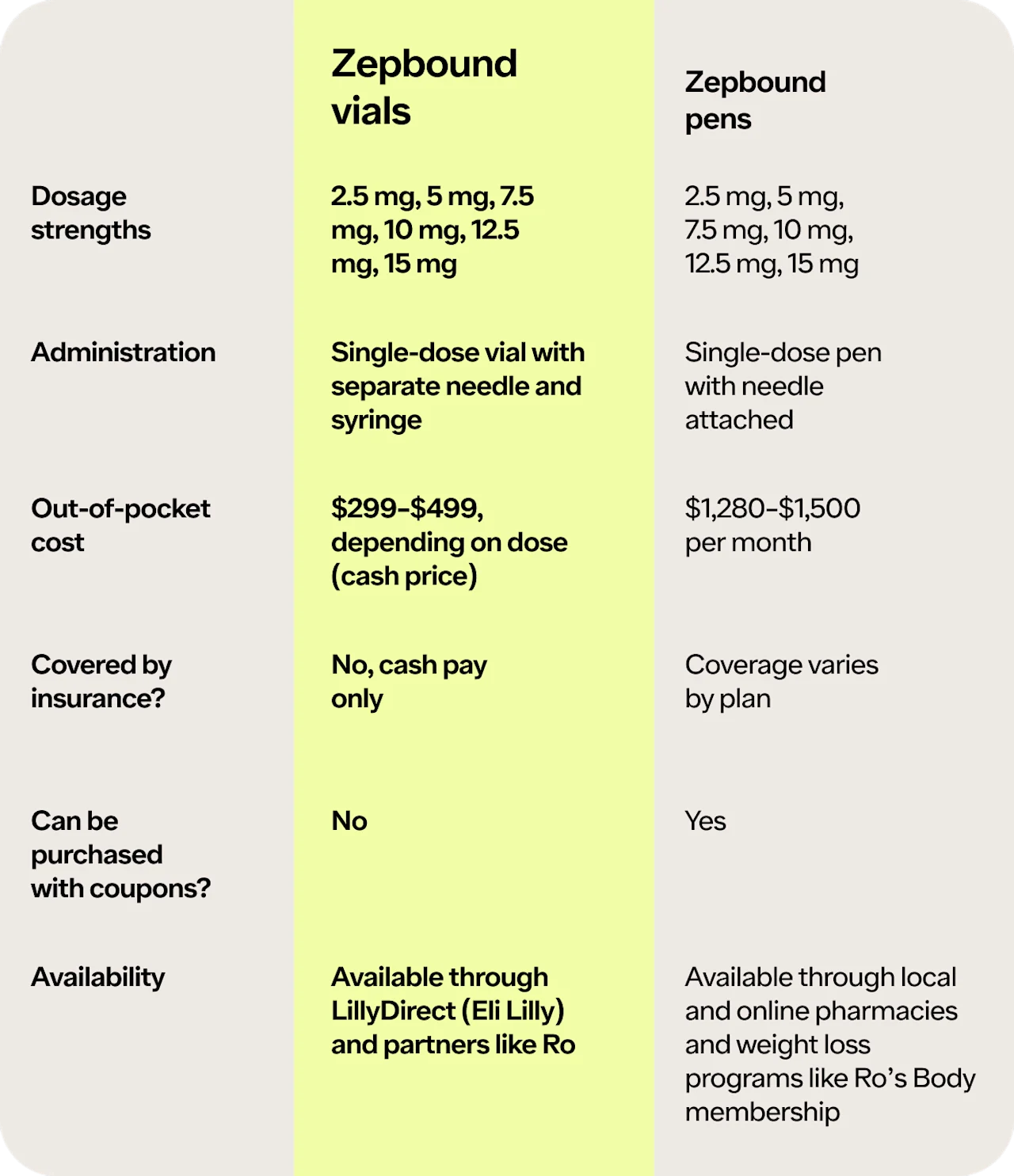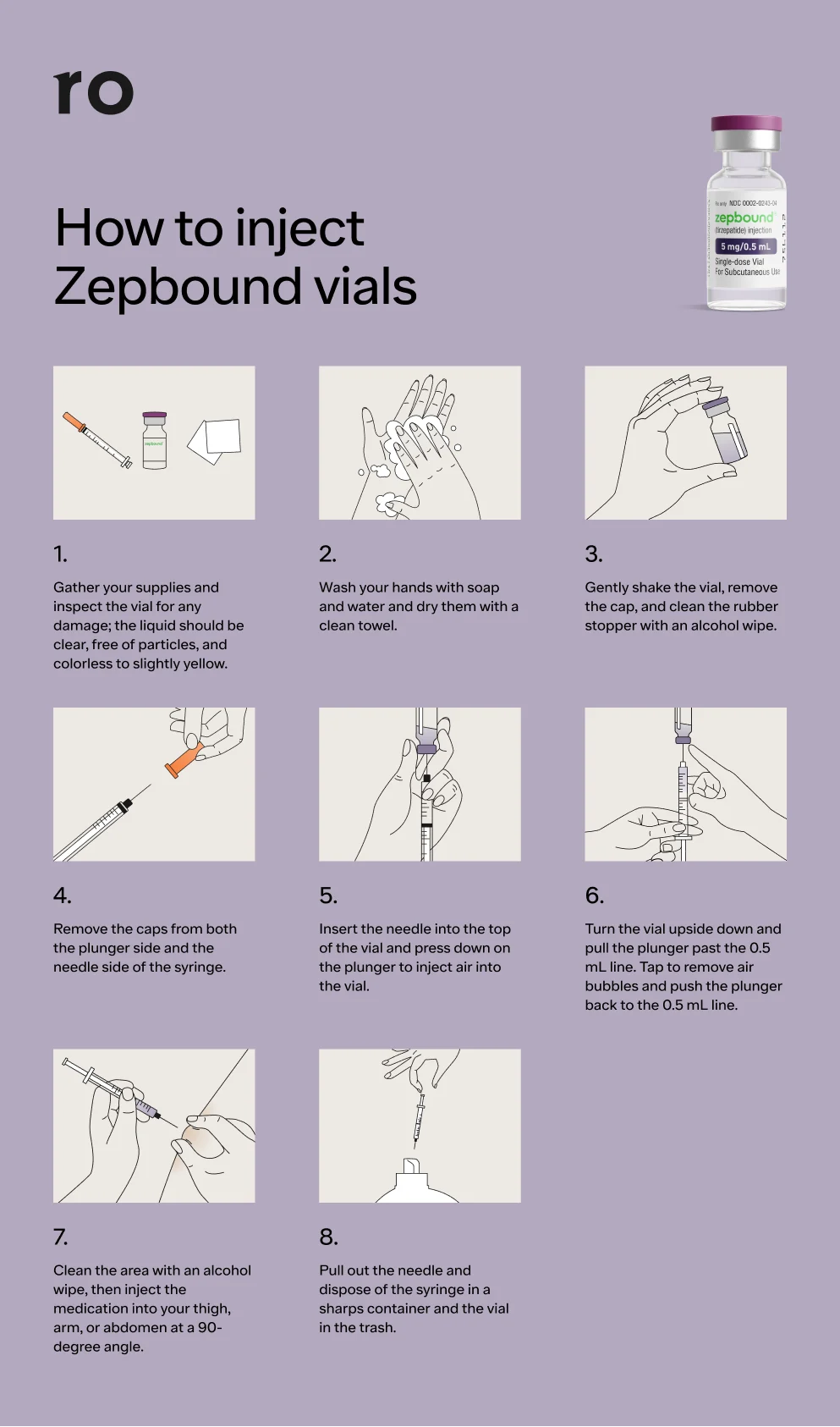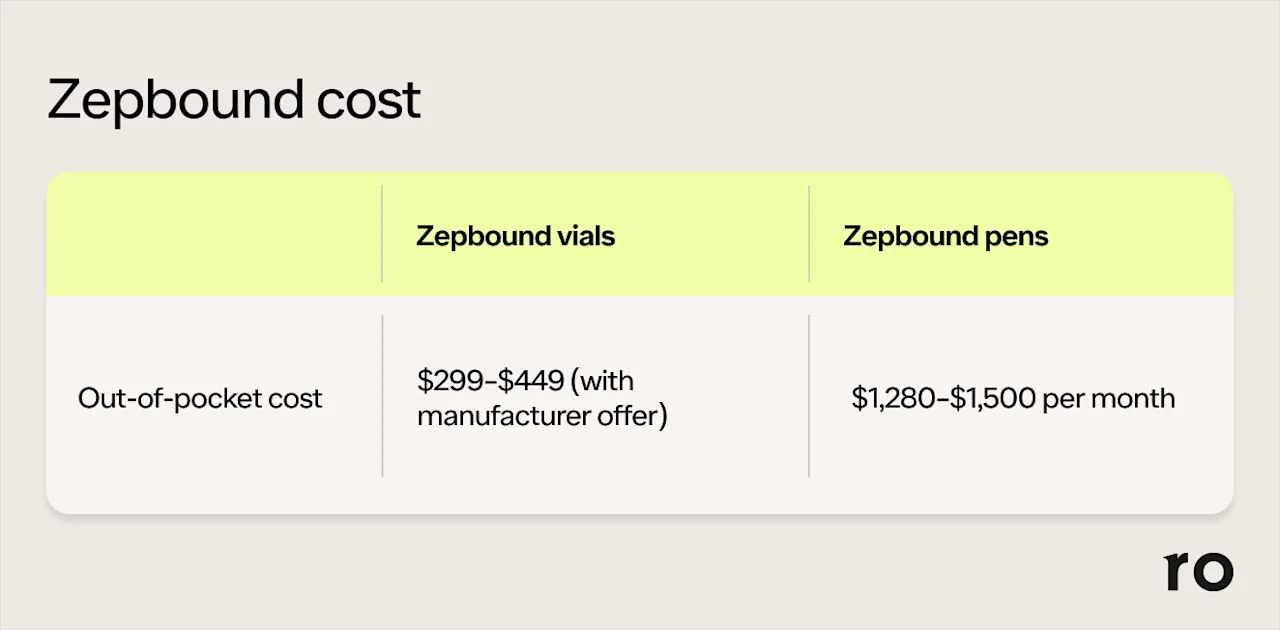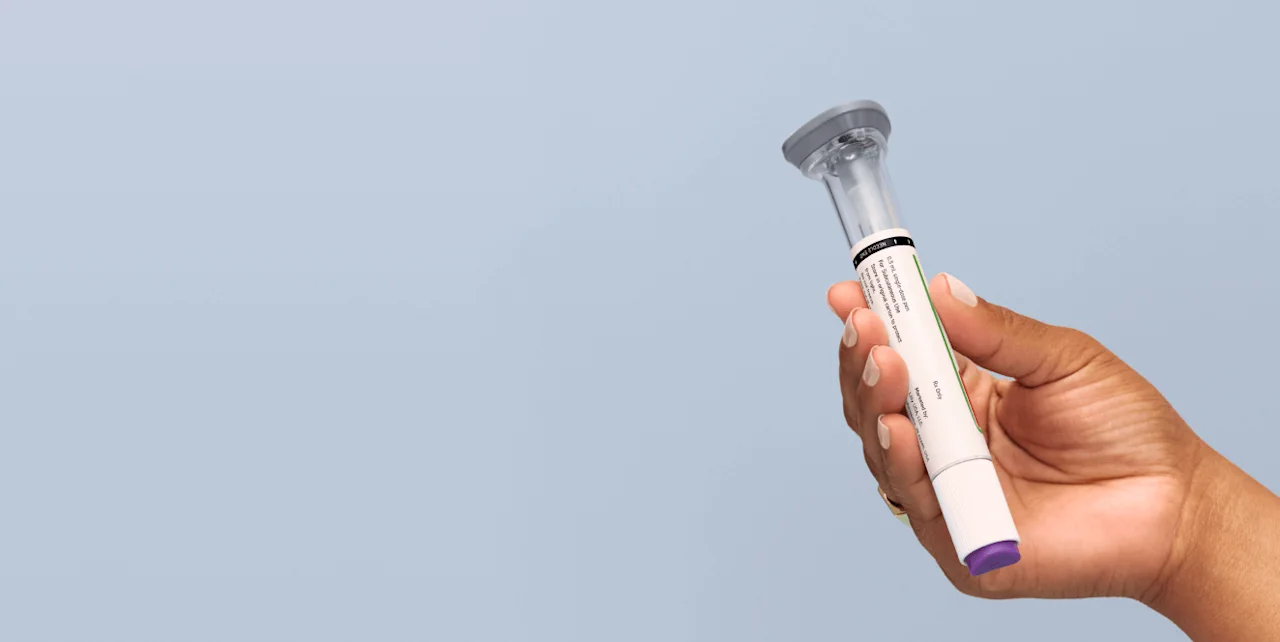Key takeaways
Zepbound vials provide the same effective weight loss medication as pens at less than half the cost, but require separate needles and syringes for administration.
Vials are available in 2.5 mg, 5 mg, 7.5 mg, 10 mg, 12.5 mg, and 15 mg doses and must be purchased directly from Eli Lilly or Ro — with a prescription from a healthcare provider, of course.
Unlike pens, Zepbound vials are not eligible for insurance coverage or discounts, making them a cash-only option.
Here's what we'll cover
Key takeaways
Zepbound vials provide the same effective weight loss medication as pens at less than half the cost, but require separate needles and syringes for administration.
Vials are available in 2.5 mg, 5 mg, 7.5 mg, 10 mg, 12.5 mg, and 15 mg doses and must be purchased directly from Eli Lilly or Ro — with a prescription from a healthcare provider, of course.
Unlike pens, Zepbound vials are not eligible for insurance coverage or discounts, making them a cash-only option.
Zepbound (tirzepatide) is one of the most effective weight loss injections available today, with people losing up to 20.9% of their body weight in clinical trials. But Zepbound is also expensive. Out-of-pocket, the drug costs over $1,000 per month. Zepbound vials, a more affordable alternative, are now available directly from Eli Lilly and Ro (yes, Ro!).
How do Zepbound vials differ from the pens? How many doses come in a Zepbound vial? In this guide to Zepbound vials, we answer those questions and more.
What are Zepbound vials?
Zepbound vials contain the same medicine approved by the US Food and Drug Administration (FDA) as the Zepbound prefilled pens — the liquid, if you will, is just housed in a different package. Like the pens, Zepbound vials are made by Eli Lilly and intended for weekly use.
They’re currently available in six dosage strengths (2.5 mg, 5 mg, 7.5 mg, 10 mg, 12.5 mg, and 15 mg). Each vial holds a single dose of the drug. You must use a separate syringe to draw the medication from Zepbound vials before administering your dose with a needle.
Zepbound vials were introduced in late August 2024 in an effort to increase supply of and accessibility to the medication. They’re available for “less than half the list price” of the Zepbound pens, according to an Eli Lilly press release.
Zepbound vials vs. pens
Zepbound vials and pens contain the same active ingredient (tirzepatide), which is a dual-action GLP-1 and GIP agonist that helps regulate your metabolism. This means you can expect the same efficacy and side effects when taken at the same dose. However, there are some key differences between Zepbound vials and pens.
Dosage strengths. Zepbound pens and vials are available in six dosage strengths: 2.5 mg, 5 mg, 7.5 mg, 10 mg, 12.5 mg, and 15 mg.
Administration. With Zepbound vials, you use a separate needle and syringe to draw out the medication yourself. Zepbound injector pens come prefilled with a needle attached.
Cost. Zepbound vials cost $299/month for the 2.5 mg, $399/month for the 5 mg dose, and $499/month for the 7.5 mg, 10 mg, 12.5 mg, and 15 mg doses (with manufacturer offer). These are cash-only prices, as the Zepbound vials are not eligible for insurance coverage. The Zepbound pens cost more than double, with a list price of $1,086.37 for a four-week supply and a retail price that averages $1,280–$1,500 per month, according to SingleCare.
Insurance coverage. Zepbound vials are not eligible for insurance coverage. They can only be purchased when paying cash. Zepbound pens, on the other hand, are eligible for insurance coverage, but insurance coverage may vary.
Coupon eligibility. Zepbound vials cannot be purchased with any coupons. Meanwhile, you can use Zepbound coupons to pay for your refill, such as the official Zepbound Savings Card from Eli Lilly (if you’re eligible) or pharmacy discount cards like those offered by certain sites (e.g. SingleCare, GoodRx).
Availability. Zepbound vials can only be purchased directly from Eli Lilly through their LillyDirect program or through Ro. Zepbound pens can be purchased from any pharmacy that has them in stock, as well as through weight loss programs such as Ro’s Body membership. Both forms of the drug require a prescription from a licensed healthcare provider.

How to use Zepbound vials
To use Zepbound vials, you’ll need to use a separate needle and syringe to draw the medication out from the vial and give yourself a shot. These needles and syringes may be included with the vials. If not, they can be purchased separately. (This is something to discuss with your pharmacies or prescriber.)
You’ll use a new needle and syringe each time you inject Zepbound.
You should always follow your healthcare provider’s advice and the instructions that come with the medication. But here’s a general idea of how to use Zepbound vials:
Gather your supplies and wash your hands with soap and water.
Pull off the plastic cap from the vial, but keep the rubber stopper intact.
Wipe the rubber stopper with an alcohol swab.
Remove the outer wrapping from the syringe and the needle. Attach the needle to the syringe if needed.
Remove the needle shield by pulling it straight off.
Hold the syringe in one hand with the needle pointing up. Use your other hand to pull down on the plunger until the tip reaches the line on the syringe indicating the 0.5 mL of air has been drawn into it.
Push the needle through the rubber stopper of the vial, then push the plunger all the way in.
With the syringe still in the vial, turn the vial and syringe upside down. Make sure that the needle tip is in the liquid and slowly pull the plunger until the plunger tip is past the 0.5 mL line. (If you see any air bubbles, tap the syringe gently a few times.)
Slowly push the plunger up until the tip reaches the 0.5 mL line.
Pull the syringe out of the vial’s rubber stopper.
Choose your injection site (i.e. abdomen, thigh, or, if someone else is giving your injection, back of your upper arm).
Insert the needle into the skin of your injection site.
Push down on the plunger to inject your dose and keep it there for at least 5 seconds.
Pull the needle out and throw it and the syringe in a FDA-cleared sharps disposal container.
If you see any blood on the skin of your injection site, dab it with gauze or an alcohol swab. Do not rub.

How many doses come in Zepbound vials?
Each Zepbound vial contains a single dose of the medication, which makes it easy to ensure you’re getting a full dose when you take the medication. Each order of Zepbound vials comes in a four-week supply. It contains four vials, each of which contains one dose of the medication.
The 2.5 mg vials cost $299, the 5 mg vials cost $399, and the 7.5 mg–15 mg vials cost $449 with the manufacturer offer.
Who is eligible for Zepbound vials?
The eligibility criteria for Zepbound vials are generally the same as for Zepbound pens since both forms of the medication are prescribed based on the drug’s FDA-approved uses.
Need a quick refresher? You got it. Zepbound is indicated in combination with diet and exercise to:
Reduce excess body weight and maintain weight reduction long term in adults with obesity or with overweight and at least one weight-related health condition (e.g. high blood pressure, high cholesterol, type 2 diabetes, heart disease)
Treat moderate-to-severe obstructive sleep apnea in adults with obesity
The choice between vials and pens is often influenced by patient preference, dosing flexibility, or specific medical needs — all of which should be discussed with a healthcare provider to best determine which form of the drug might be the best fit for you.
How to get Zepbound vials
You can get Zepbound vials through Eli Lilly and directly through Ro.
As of mid-December, Ro and Eli Lilly partnered to offer a complete end-to-end experience, providing access to the Zepbound vials on a single platform. You can meet with a provider and get a prescription for Zepbound vials (if appropriate) at the same time through Ro.
After you complete an online health questionnaire, you’ll be connected with a healthcare provider who can prescribe Zepbound vials (or another GLP-1 medication, if appropriate). Then, your Zepbound vials will be shipped directly to you.
If you already have a prescription and want to purchase through Eli Lilly, visit the LillyDirect website. After you select “Zepbound” from the dropdown menu, you’ll see the NPI and NCPDP numbers you’ll need to share with your healthcare provider so they can send your prescription to LillyDirect pharmacy providers.
Zepbound vials cost
Zepbound vials cost between $299 and $449, depending on your prescribed dose and as long as you’re using (and following the instructions of!) the manufacturer offer.
Impressed by these numbers? Makes sense since they’re the lowest prices of tirzepatide currently available. Here’s a complete breakdown:
$299/month for 2.5 mg dose
$399 per month for 5 mg dose
$449 per month (with manufacturer offer) for 7.5 mg, 10 mg, 12.5 mg, and 15 mg doses
To keep this discounted price for the 7.5 mg–15 mg doses, you must complete your next refill check-in within 45 days of your last delivery. If you miss that window, you’ll be charged:
$599 for a 7.5 mg refill
$699 for a 10 mg refill
$849 for a 12.5 mg refill
$1,049 for a 15 mg refill
But don’t worry: Ro will send you plenty of reminders to complete your refill as the deadline approaches.
The Zepbound vials cost less than half the list price of Zepbound pens, which is $1,086.37 for a four-week supply. The list price is the price at which Eli Lilly sells the products to wholesalers, so the retail price of Zepbound tends to be even higher. According to SingleCare, the average monthly price of Zepbound ranges from $1,280 to $1,500, depending on the pharmacy.

Bottom line
Zepbound vials offer an accessible, cost-effective alternative to Zepbound pens, making this breakthrough weight loss medication more affordable for people who don’t have insurance coverage for Zepbound. Here’s a recap:
Zepbound vials are available in the same dosage strengths as the pens. Both come in 2.5 mg, 5 mg, 7.5 mg, 10 mg, 12.5 mg, and 15 mg doses.
Zepbound vials cost less than half the cash price of Zepbound pens. Zepbound vials cost $299–$449 (with manufacturer offer) for a four-week supply, while a four-pack of Zepbound pens ranges from $1,280–$1,500 per month. However, the vials are not eligible for insurance or coupons and can only be purchased when paying cash.
Zepbound vials and pens each contain a single dose of the medication. Vials require the use of a separate needle and syringe, while pens come with a needle already attached.
While Zepbound vials require a few more steps to administer the medication, the savings can be well worth it. Talk to your healthcare provider to determine whether Zepbound vials or pens are the best fit for you.
Frequently asked questions (FAQs)
What is the cheapest way to get Zepbound?
The cheapest way to get Zepbound is to have an insurance plan that covers it. If that’s your situation, you may be able to get Zepbound for free, depending on your insurance plan, or at most pay $25 for the medication if you qualify for the Zepbound Savings Card. This card brings the cost of Zepbound down to as low as $25 for a one- or three-month supply for those with a commercial insurance plan that includes coverage for Zepbound. (For those with a commercial insurance plan that doesn’t cover Zepbound, the Savings Card caps the price at $650 for a one-month supply.) The Zepbound Savings Card can only be used on refills of the Zepbound pens, not the vials.
If you don’t have commercial insurance, the next cheapest way to get Zepbound is to use the Zepbound vials, which are available through Eli Lilly’s LillyDirect program and Ro and shipped directly to your home. The Zepbound vials cost:
$299/month: 2.5 mg dose
$399/month: 5 mg dose
$449/month (with manufacturer offer): 7.5 mg–15 mg doses
Zepbound vials can only be purchased when paying cash. They’re not eligible for insurance coverage.
What is the difference between a Zepbound pen and a vial?
Zepbound pens and vials contain the same FDA-approved medication and come in the same dosage strengths. Here’s where they differ:
Formulation and administration: Zepbound pens come prefilled with the medication and have a needle attached, while with Zepbound vials, you’ll use a separate needle and syringe to draw out the medication.
Costs: Zepbound vials cost less than half the out-of-pocket cost of Zepbound pens. However, they can only be purchased when paying cash and are not eligible for insurance coverage. (For what it’s worth, insurance coverage of Zepbound isn’t a guarantee.)
Availability: You can buy Zepbound pens with a valid prescription from any pharmacy that has Zepbound in stock, while the vials can only be purchased through Eli Lilly and partner pharmacies like Ro.
DISCLAIMER
If you have any medical questions or concerns, please talk to your healthcare provider. The articles on Health Guide are underpinned by peer-reviewed research and information drawn from medical societies and governmental agencies. However, they are not a substitute for professional medical advice, diagnosis, or treatment.
Zepbound Important Safety Information: Read more about serious warnings and safety info.
GLP-1 Important Safety Information: Read more about serious warnings and safety info.
References
Eli Lilly-a. (2024). How do I get Zepbound (tirzepatide) vials?. Retrieved from https://medical.lilly.com/us/products/answers/how-do-i-get-zepbound-tirzepatide-vials-250061
Eli Lilly-b. (2024). How much should I expect to pay for Zepbound (tirzepatide)?. Retrieved from https://pricinginfo.lilly.com/zepbound
Eli Lilly-c. (2024). Lilly releases Zepbound (tirzepatide) single-dose vials, expanding supply and access for adults living with obesity. Retrieved from https://investor.lilly.com/news-releases/news-release-details/lilly-releases-zepboundr-tirzepatide-single-dose-vials-expanding
Eli Lilly-d. (2024). Savings Card, Cost & Coverage Support | Zepbound (tirzepatide). Retrieved from https://www.zepbound.lilly.com/coverage-savings
Jastreboff, A. M., Aronne, L. J., Ahmad, N. N., et al. (2022). Tirzepatide Once Weekly for the Treatment of Obesity. The New England Journal of Medicine, 387(3), 205–216. doi: 10.1056/NEJMoa2206038. Retrieved from https://www.nejm.org/doi/10.1056/NEJMoa2206038
SingleCare. (n.d.). Zepbound Coupons & Prices. Retrieved from https://www.singlecare.com/prescription/zepbound
U.S. Food & Drug Administration (FDA). (2025). Highlights of Prescribing Information: Zepbound (tirzepatide) Injection, for subcutaneous use. Retrieved from https://www.accessdata.fda.gov/drugsatfda_docs/label/2025/217806s031lbl.pdf














